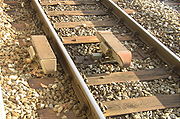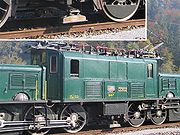
Integra-Signum
Encyclopedia

Electromagnetic induction
Electromagnetic induction is the production of an electric current across a conductor moving through a magnetic field. It underlies the operation of generators, transformers, induction motors, electric motors, synchronous motors, and solenoids....
and is simple, robust and reliable also in snow.
How it works
The locomotives have three sending and receiving magnetMagnet
A magnet is a material or object that produces a magnetic field. This magnetic field is invisible but is responsible for the most notable property of a magnet: a force that pulls on other ferromagnetic materials, such as iron, and attracts or repels other magnets.A permanent magnet is an object...
s and there are two trackside magnets near the signals
Railway signal
A signal is a mechanical or electrical device erected beside a railway line to pass information relating to the state of the line ahead to train/engine drivers. The driver interprets the signal's indication and acts accordingly...
.
Integra-Signum asks the train driver to confirm distant signals that show stop and distant or home signals that show caution. If he does not confirm or passes a home signal that shows stop, the train is stopped automatically. This is achieved by interrupting the power supply to the motors and applying the emergency brake.
The locomotive's sending magnet is a strong permanent magnet, which induces a current in the receiving magnet in the middle of the track, if the signal's short-circuit contact is closed. The receiving magnet on the locomotive consists of two magnet field detectors, which detect the signal's state according to polarity and timing of the magnetic field emitted by the second magnet outside the track:

Caution (distant signals): negative - positive, concurrent
Caution (home signal): positive - positive, not concurrent
Because Integra-Signum can only stop a train when it's "too late", i.e. after the red signal, it is not sufficient if there is an obstacle less than the braking distance away from the signal, which is especially a problem with fast trains. To address this issue, Zugbeeinflussung ZUB
Zub
Zub is a game written for the Amstrad CPC, Commodore 64 and ZX Spectrum which was published in 1986 by Mastertronic and was written by John and Ste Pickford on the ZX Spectrum and Phillip Brian Allsopp on the Commodore 64 with music on all formats composed by David Whittaker.Zub is in the employ of...
has been introduced. Both systems are supposed to be replaced some time in the future by the European Train Control System.
Despite that Integra-Signum aims to prevent accidents, there was also an accident caused by it. In 1959, an Integra-Signum magnet mounted on a SBB-CFF-FFS RBe 540
SBB-CFF-FFS RBe 540
Starting in 1959, the SBB-CFF-FFS put motored coaches of the type RBe 540 into service for push-pull operation on the Gotthard line...
EMU tore out a wooden sleeper on a level crossing near Gland
Gland, Switzerland
Gland is a municipality in the district of Nyon in the canton of Vaud in Switzerland.-History:Gland is known to have been a prehistoric settlement. During the Roman period a farm called Villa Glanis was there...
, which led to the derailment of the entire train at 125 km/h.
See also
- Train protection system
- Integra SignumIntegra SignumIntegra Signum was a publicly-traded Swiss company active in train control and signaling systems. Its main achievement was the development of the train control system Integra-Signum, which was subsequently adopted by the Swiss Federal Railways in 1933...
, the company that developed the system

